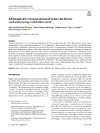Identificador persistente para citar o vincular este elemento:
https://accedacris.ulpgc.es/jspui/handle/10553/114275
| Título: | Advantages of in vivo measurement of human skin thermal conductance using a calorimetric sensor | Autores/as: | Rodríguez De Rivera Socorro, Pedro Jesús Rodríguez de Rivera, Miriam Socorro Lorenzo, Fabiola Lourdes López Calbet, José Antonio Rodríguez De Rivera Rodríguez, Manuel Jose M. |
Clasificación UNESCO: | 220201 Conductividad 241109 Regulación de la temperatura humana |
Palabras clave: | Direct Calorimetry Medical Calorimetry Skin Heat Loss Skin Thermal Properties Thermal Conductance |
Fecha de publicación: | 2022 | Publicación seriada: | Journal of Thermal Analysis and Calorimetry | Resumen: | Thermal conductivity of the skin has been measured by in vivo procedures since the 1950s. These devices usually consist of temperature sensors and heating elements. In vivo measurement of skin thermal conductivity entails several difficulties. It is necessary to adequately characterize the excitation produced by the measurement. In addition, the thermal penetration depth of each instrument is different. These factors have led to the development of a multitude of techniques to measure the thermal conductivity or related magnitudes such as thermal conductance. In our case, we have built a calorimetric sensor designed to measure this magnitude directly and non-invasively. The device implements the basic principles of calorimetry and is capable of characterizing the thermal magnitudes of a 2 × 2 (4) cm2 skin region. The sensor consists of a measuring thermopile with a thermostat cooled by Peltier effect. Several skin measurements performed under different conditions resulted in a thermal conductance ranging from 0.017 to 0.050 WK−1. This magnitude, measured in vivo, is different in each studied area and depends on several factors, such as physical activity and the physiological state of the subject. This new sensor is a useful tool for studying the human body thermoregulatory response. | URI: | https://accedacris.ulpgc.es/handle/10553/114275 | ISSN: | 1388-6150 | DOI: | 10.1007/s10973-022-11275-x | Fuente: | Journal of Thermal Analysis and Calorimetry [ISSN 1388-6150], (Enero 2022) |
| Colección: | Artículo preliminar |
Citas SCOPUSTM
12
actualizado el 08-jun-2025
Citas de WEB OF SCIENCETM
Citations
13
actualizado el 08-jun-2025
Visitas
65
actualizado el 10-jun-2023
Descargas
17
actualizado el 10-jun-2023
Google ScholarTM
Verifica
Altmetric
Comparte
Exporta metadatos
Los elementos en ULPGC accedaCRIS están protegidos por derechos de autor con todos los derechos reservados, a menos que se indique lo contrario.
